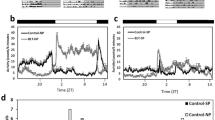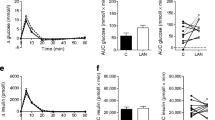Abstract
The aim of this study was to investigate whether the entrainment of light cue is affected or not in diabetic animals. We found that the individual light/dark (LD) reversal showed a tissue- and gene-specific effect on the circadian phases of peripheral clock genes, which was generally similar between the control and diabetic rats. In the liver and heart, the peak phases of examined clock genes (Bmal1, Rev-erbα, Per1, and Per2) were slightly shifted by 0∼4 h in the liver and heart of control and diabetic rats. However, we found that the peak phases of these clock genes were greatly shifted by 8∼12 h after the LD reversal for 7 days in the pineal gland of both control and diabetic rats. However, the activity rhythm was greatly different between two groups. After the individual LD reversal, the activity rhythm was completely shifted in the control rats but retained in the diabetic rats. These observations suggested that the behavioral rhythm of diabetic rats may be uncoupled from the master clock after the individual LD reversal. Moreover, we also found that the serum glucose levels of diabetic rats kept equally high throughout the whole day without any shift of peak phase after the individual reversal of LD cycle. While the serum glucose levels of control rats were tightly controlled during the normal and LD reversal conditions. Thus, the impaired insulin secretion induced uncontrollable serum glucose level may result in uncoupled activity rhythm in the diabetic rats after the individual LD reversal.





Similar content being viewed by others
References
Albrecht U, Sun ZS, Eichele G, Lee CC (1997) A differential response of two putative mammalian circadian regulators, mper1 and mper2, to light. Cell 91:1055–1064
Ando H, Ushijima K, Kumazaki M, Eto T, Takamura T, Irie S, Kaneko S, Fujimura A (2010) Associations of metabolic parameters and ethanol consumption with messenger RNA expression of clock genes in healthy men. Chronobiol Int 27:194–203
Balsalobre A, Marcacci L, Schibler U (2000) Multiple signaling pathways elicit circadian gene expression in cultured Rat-1 fibroblasts. Curr Biol 10:1291–1294
Bostwick J, Nguyen D, Cornelissen G, Halberg F, Hoogerwerf WA (2010) Effects of acute and chronic STZ-induced diabetes on clock gene expression and feeding in the gastrointestinal tract. Mol Cell Biochem 338:203–213
Damiola F, Le Minh N, Preitner N, Kornmann B, Fleury-Olela F, Schibler U (2000) Restricted feeding uncouples circadian oscillators in peripheral tissues from the central pacemaker in the suprachiasmatic nucleus. Genes Dev 14:2950–2961
Dibner C, Schibler U, Albrecht U (2010) The mammalian circadian timing system: organization and coordination of central and peripheral clocks. Annu Rev Physiol 72:517–549
Dickmeis T (2009) Glucocorticoids and the circadian clock. J Endocrinol 200:3–22
Hara R, Wan K, Wakamatsu H, Aida R, Moriya T, Akiyama M, Shibata S (2001) Restricted feeding entrains liver clock without participation of the suprachiasmatic nucleus. Genes Cells 6:269–278
Herichova I, Zeman M, Stebelova K, Ravingerova T (2005) Effect of streptozotocin-induced diabetes on daily expression of per2 and dbp in the heart and liver and melatonin rhythm in the pineal gland of Wistar rat. Mol Cell Biochem 270:223–229
Kudo T, Akiyama M, Kuriyama K, Sudo M, Moriya T, Shibata S (2004) Night-time restricted feeding normalises clock genes and Pai-1 gene expression in the db/db mouse liver. Diabetologia 47:1425–1436
Kuriyama K, Sasahara K, Kudo T, Shibata S (2004) Daily injection of insulin attenuated impairment of liver circadian clock oscillation in the streptozotocin-treated diabetic mouse. FEBS Lett 572:206–210
Le Minh N, Damiola F, Tronche F, Schutz G, Schibler U (2001) Glucocorticoid hormones inhibit food-induced phase-shifting of peripheral circadian oscillators. EMBO J 20:7128–7136
Lowrey PL, Takahashi JS (2004) Mammalian circadian biology: elucidating genome-wide levels of temporal organization. Annu Rev Genomics Hum Genet 5:407–441
Oishi K, Kasamatsu M, Ishida N (2004) Gene- and tissue-specific alterations of circadian clock gene expression in streptozotocin-induced diabetic mice under restricted feeding. Biochem Biophys Res Commun 317:330–334
Paschos GK, FitzGerald GA (2010) Circadian clocks and vascular function. Circ Res 106:833–841
Portaluppi F, Touitou Y, Smolensky MH (2008) Ethical and methodological standards for laboratory and medical biological rhythm research. Chronobiol Int 25:999–1016
Prasai MJ, George JT, Scott EM (2008) Molecular clocks, type 2 diabetes and cardiovascular disease. Diab Vasc Dis Res 5:89–95
Reddy AB, Maywood ES, Karp NA, King VM, Inoue Y, Gonzalez FJ, Lilley KS, Kyriacou CP, Hastings MH (2007) Glucocorticoid signaling synchronizes the liver circadian transcriptome. Hepatology 45:1478–1488
Reddy TE, Pauli F, Sprouse RO, Neff NF, Newberry KM, Garabedian MJ, Myers RM (2009) Genomic determination of the glucocorticoid response reveals unexpected mechanisms of gene regulation. Genome Res 19:2163–2171
Reppert SM, Weaver DR (2002) Coordination of circadian timing in mammals. Nature 418:935–941
Schibler U, Sassone-Corsi P (2002) A web of circadian pacemakers. Cell 111:919–922
Shearman LP, Zylka MJ, Weaver DR, Kolakowski LF Jr, Reppert SM (1997) Two period homologs: circadian expression and photic regulation in the suprachiasmatic nuclei. Neuron 19:1261–1269
Shigeyoshi Y, Taguchi K, Yamamoto S, Takekida S, Yan L, Tei H, Moriya T, Shibata S, Loros JJ, Dunlap JC, Okamura H (1997) Light-induced resetting of a mammalian circadian clock is associated with rapid induction of the mPer1 transcript. Cell 91:1043–1053
Staels B (2006) When the clock stops ticking, metabolic syndrome explodes. Nat Med 12:54–55, discussion 55
Stephan FK, Davidson AJ (1998) Glucose, but not fat, phase shifts the feeding-entrained circadian clock. Physiol Behav 65:277–288
Stokkan KA, Yamazaki S, Tei H, Sakaki Y, Menaker M (2001) Entrainment of the circadian clock in the liver by feeding. Science 291:490–493
Tahara Y, Otsuka M, Fuse Y, Hirao A, Shibata S (2011) Refeeding after fasting elicits insulin-dependent regulation of Per2 and Rev-erbα with shifts in the liver clock. J Biol Rhythms 26:230–240
Wakamatsu H, Yoshinobu Y, Aida R, Moriya T, Akiyama M, Shibata S (2001) Restricted-feeding-induced anticipatory activity rhythm is associated with a phase-shift of the expression of mPer1 and mPer2 mRNA in the cerebral cortex and hippocampus but not in the suprachiasmatic nucleus of mice. Eur J Neurosci 13:1190–1196
Wu T, Jin Y, Kato H, Fu Z (2008) Light and food signals cooperate to entrain the rat pineal circadian system. J Neurosci Res 86:3246–3255
Wu T, Jin Y, Ni Y, Zhang D, Kato H, Fu Z (2008) Effects of light cues on re-entrainment of the food-dominated peripheral clocks in mammals. Gene 419:27–34
Wu T, Ni Y, Dong Y, Xu J, Song X, Kato H, Fu Z Regulation of circadian gene expression in the kidney by light and food cues in rats. Am J Physiol Regul Integr Comp Physiol 298(3):635–641
Wu T, Ni Y, Zhuge F, Sun L, Xu B, Kato H, Fu Z Significant dissociation of expression patterns of the basic helix-loop-helix transcription factors Dec1 and Dec2 in rat kidney. J Exp Biol 214:1257–1263
Wu T, Zhuge F, Sun L, Ni Y, Fu O, Gao G, Chen J, Kato H, Fu Z (2012) Enhanced effect of daytime restricted feeding on the circadian rhythm of streptozotocin-induced type 2 diabetic rats. Am J Physiol Endocrinol Metab 302:E1027–E1035
Yoo SH, Yamazaki S, Lowrey PL, Shimomura K, Ko CH, Buhr ED, Siepka SM, Hong HK, Oh WJ, Yoo OJ, Menaker M, Takahashi JS (2004) PERIOD2: LUCIFERASE real-time reporting of circadian dynamics reveals persistent circadian oscillations in mouse peripheral tissues. Proc Natl Acad Sci U S A 101:5339–5346
Young ME, Wilson CR, Razeghi P, Guthrie PH, Taegtmeyer H (2002) Alterations of the circadian clock in the heart by streptozotocin-induced diabetes. J Mol Cell Cardiol 34:223–231
Acknowledgments
This work was supported by a grant from the National Natural Science Foundation of China (No. 31200890), the Natural Science Foundation of Zhejiang Province, China (No. Y3090563).
Conflict of interest
The authors have no conflict of interest to declare.
Author information
Authors and Affiliations
Corresponding author
Additional information
Tao Wu and Fen ZhuGe contributed equally to this study.
Electronic Supplementary Material
Below is the link to the electronic supplementary material.
ESM 1
(DOC 381 kb)
Rights and permissions
About this article
Cite this article
Wu, T., ZhuGe, F., Zhu, Y. et al. Effects of light on the circadian rhythm of diabetic rats under restricted feeding. J Physiol Biochem 70, 61–71 (2014). https://doi.org/10.1007/s13105-013-0281-4
Received:
Accepted:
Published:
Issue Date:
DOI: https://doi.org/10.1007/s13105-013-0281-4




